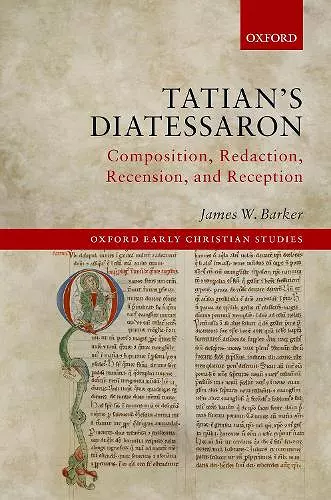Tatian's Diatessaron
Composition, Redaction, Recension, and Reception
Format:Hardback
Publisher:Oxford University Press
Published:28th Oct '21
Currently unavailable, and unfortunately no date known when it will be back

In the late-second century, Tatian the Assyrian constructed a new Gospel by intricately harmonizing Matthew, Mark, Luke, and John. Tatian's work became known as the Diatessaron, since it was derived 'out of the four' eventually canonical Gospels. Though it circulated widely for centuries, the Diatessaron disappeared in antiquity. Nevertheless, numerous ancient and medieval harmonies survive in various languages. Some texts are altogether independent of the Diatessaron, while others are definitely related. Yet even Tatian's known descendants differ in large and small ways, so attempts at reconstruction have proven confounding. In this book James W. Barker forges a new path in Diatessaron studies. Covering the widest array of manuscript evidence to date, Tatian's Diatessaron reconstructs the compositional and editorial practices by which Tatian wrote his Gospel. By sorting every extant witnesses according to its narrative sequence, the macrostructure of Tatian's Gospel becomes clear. Despite many shared agreements, there remain significant divergences between eastern and western witnesses. This book argues that the eastern ones preserve Tatian's order, whereas the western texts descend from a fourth-century recension of the Diatessaron. Victor of Capua and his scribe used the recension to produce the Latin Codex Fuldensis in the sixth century. More controversially, Barker offers new evidence that late medieval texts such as the Middle Dutch Stuttgart harmony independently preserve traces of the western recension. This study uncovers the composition and reception history behind one of early Christianity's most elusive texts.
Barker has familiarized himself with dozens of manuscript witnesses in Latin, Dutch, German, English, and Italian dialects from microfilms and digital images, many of them unpublished. This is a huge step toward having an informed discussion about extant medieval Western harmony sources and their filiation. Barker is to be praised and applauded for making this effort. * Ulrich B. Schmid, Kirchlichen Hochschule Wuppertal/Bethel, Review of Biblical Literature *
Barker's study takes the field in exactly the direction I have envisioned it should go. In just a matter of years, Barker has produced a tour-de-force that I had imagined it would take a lifetime to complete. All future research on the Diatessaron, including my own, will refer back to this seminal study. * Nicholas J. Zola, Pepperdine University, Journal of Theological Studies *
Barker's work is important, especially for specialists in Diatessaronic studies. However, for those new to the discipline it is a highly important work which will make readers aware of the current state of research and the difficult and contested issues that surround this topic. As such it is a fine piece of scholarship that will, no doubt, have enduring value. * Paul Foster, University of Edinburgh, Expository Times *
This careful and succinct study offers an important contribution to our understanding of how Tatian created his mind-boggling text, while also tracing, sometimes controversially, the twists and turns of its ongoing development and reception. * Alan Garrow, Journal for the Study of the New Testament *
Barker has produced a tour-de-force that I had imagined it would take a lifetime to complete. All future research on the Diatessaron, including my own, will refer back to this seminal study. * Nicholas J Zola, Journal of Theological Studies *
ISBN: 9780192844583
Dimensions: 241mm x 165mm x 17mm
Weight: 422g
168 pages